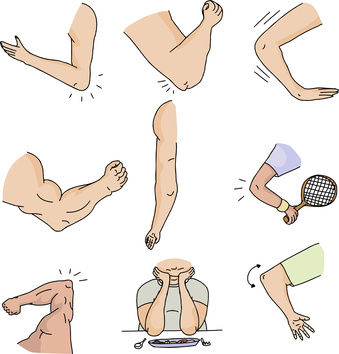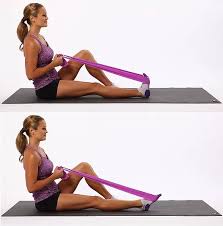Elbow Exercise: Health Benefits, How to do ?- Variation
What is Elbow Exercise?
After any elbow problem, it’s essential to get movement and strength back. This supports tissue healing and will assist you get moving again. You may not be able to return to your usual exercise levels urgently and improvements may be slow to start with. However, a gradual return to normal activities is a good way to get good short and long-term results after an elbow problem.
When performing the exercise you should listen to your pain levels, especially in the early stages. You may find that these exercises rises your symptoms slightly in the beginning. However, they should get easier over time and, with daily practice, can aid to improve movement in the elbow.
It’s pretty easy to go your entire life without ever thinking about your elbows. Until one day you can barely flex your arm anymore. Then suddenly your training (or whatever activities you’re into) gets agonizing. It turns out elbow pain is more usual than you might think, especially if you’re a pretty active person. Because when you think about it, pretty much every upper body motion you do has to be translated through these two little hinges in your arms. And the more repetition and power you’re using, the more at risk your elbows are for overuse injuries.
Anatomy of Elbow Joint
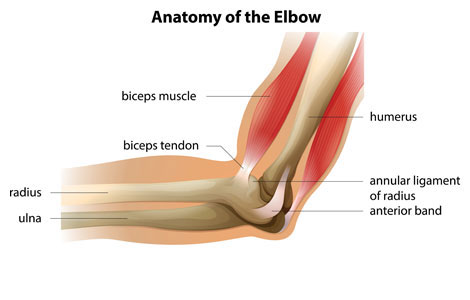
The elbow joint is a synovial joint formed in the upper limb between the arm and the forearm. It is the place of articulation of three bones: the humerus of the arm and the radius and the ulna of the forearm.
The elbow joint is distinguished structurally as a synovial joint. It is also distinguished structurally as a compound joint, as there are two articulations in the joint. Synovial joints, also known as diarthrosis, are free movable joints. The articular surfaces of the bones at these joints are divided from each other by a layer of hyaline cartilage. Smooth motion at these joints is provided by a highly viscous synovial fluid, which acts as a lubricant.
A fibrous capsule surrounds the joint and is lined internally by a synovial membrane. Synovial joints can be further classified based on function. The elbow joint is functionally a hinge joint, allowing motion in only one plane (uniaxial).
What are the Health Benefits of Elbow exercises?
There are some common benefits of elbow joint exercises:
- Activating muscles and blood flow: Stretching your elbows can activate your forearm and shoulder muscles and increase blood flow to the area. Stretching makes it easier to utilize the forearm muscles when performing a strenuous exercise program like yoga, strength training, or lifting weights.
- Increasing your short-term range of motion: Elbow stretches improve the range of motion of your elbow and forearms, allowing you to do deeper stretches or fully activate a particular muscle. If you feel a lot of stiffness or tightness in your elbows or are about to perform an arm workout and want to do as much of each movement as possible, elbow stretches can be a great option.
- Increase long-term flexibility: Over time, consistent, safe elbow stretches can improve the long-term flexibility of your elbows and forearms, allowing you to do deeper stretches and hold them longer. Better long-term elbow mobility can also aid mitigate elbow pain from sprains, or tendonitis (inflammation of tendons).
- Relieve muscle soreness: Athletes commonly stretch before or after a workout to relieve muscle soreness. Stretching your elbows may offer relief in the form of a placebo effect since it activates your muscles and can aid you to believe that your soreness will subside.
- Elbow exercises increase flexibility: The elbow is capable of some range of motions, including pronation, supination, and flexion and extension. Elbow exercises aid to stretch the ligaments in the elbow to promote wrist mobility and increase flexibility.
- Elbow exercises help prevent elbow pain and injury: Weak elbows are more prone to fractures and sprains. Repetitive motions can cause elbow pain by placing undue stress on the muscles. Building strength in your elbow muscles aids alleviate stress on the muscles and provides strength to protect the elbows from injury.
Some Exercises for Elbow joint-related Conditions
- Golfers elbow exercise
- Tennis Elbow Eccentric Exercise
- Elbow Exercise after Surgery
- Exercise for Elbow Stiffness
- Elbow ROM Exercise
Golfers elbow exercise
Here are some exercises that relieve golfer’s elbow pain:
- Isometric wrist strengthening (extension)
- Isometric wrist strengthening (flexion)
- Resisted wrist extension
- Resisted wrist flexion
- Golfer’s elbow stretch
- Wrist/forearm soft tissue rolling
- Wrist flexion/extension stretch
- Open book
- Supine (or seated) thoracic extension with a foam roll, towel roll, or low back chair (for seated)
- Latissumus dorsi stretch
- Shoulder/scapular wall slide
Isometric wrist strengthening (extension)

Keep your body stable throughout this exercise.
While seated, put your affected forearm on a table or the arm of a chair with your palm facing down.
Put your other hand on the back of your affected hand.
Compress your affected hand up, using your opposite hand to form resistance by pressing down.
Continue for 10 seconds, slowly raising the resistance.
Gently release. Perform 15 reps.
Isometric wrist strengthening (flexion)

Keep your body stable while doing this exercise.
While seated, place your affected forearm on a table or the arm of a chair with your palm facing up.
Press your other palm into your affected hand.
Press your affected hand upwards as you utilize your opposite hand to create resistance by pressing down.
Continue for 10 seconds, gently increasing the resistance.
Gently release. Perform 15 reps.
Resisted wrist extension

While seated, grab a weight with your affected arm.
Put your forearm on a table or the arm of a chair with the hand hanging over the edge and your palm facing down.
Slowly lower your hand down before lifting it back to the original position.
Perform 1–3 sets of 15 reps.
Resisted wrist flexion
While seated, Grab a weight with your affected arm.
Put your forearm on a table or the arm of a chair with the hand hanging over the edge and your palm facing up.
Slowly lower your hand down before lifting it back to the original position.
Perform 1–3 sets of 15 reps.
Golfer’s elbow stretch
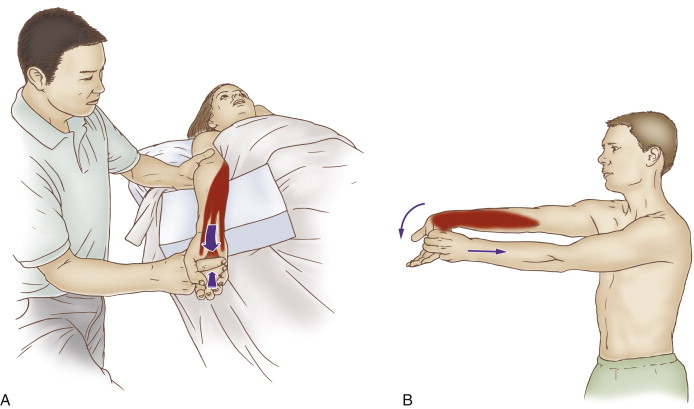
You will feel this stretch on the underside of your forearm.
Extend the affected arm in front of you with your fingers and palm facing up.
Utilize your opposite hand to slowly pull your fingers and wrist down toward your body.
Pause this stretch for 30 seconds.
Perform 2–5 reps.
Wrist/forearm soft tissue rolling
Take a rounded object like a tennis or lacrosse ball.
Place your forearm (the lower half of your arm) on top of the ball with your palm facing up or down.
Slowly roll your whole forearm up and down the ball 10 to 15 times.
Stop on spots that feel extra sore. Flex and extend your wrists while keeping pressure.
You can perform soft tissue rolling a few times a day. Utilize less or more pressure, depending on how sensitive the area is.
Wrist flexion/extension stretch
Extend your arm.
Flex your wrist down and up until you feel the tension in both directions.
Do 20 to 30 times several times a day.
Open book
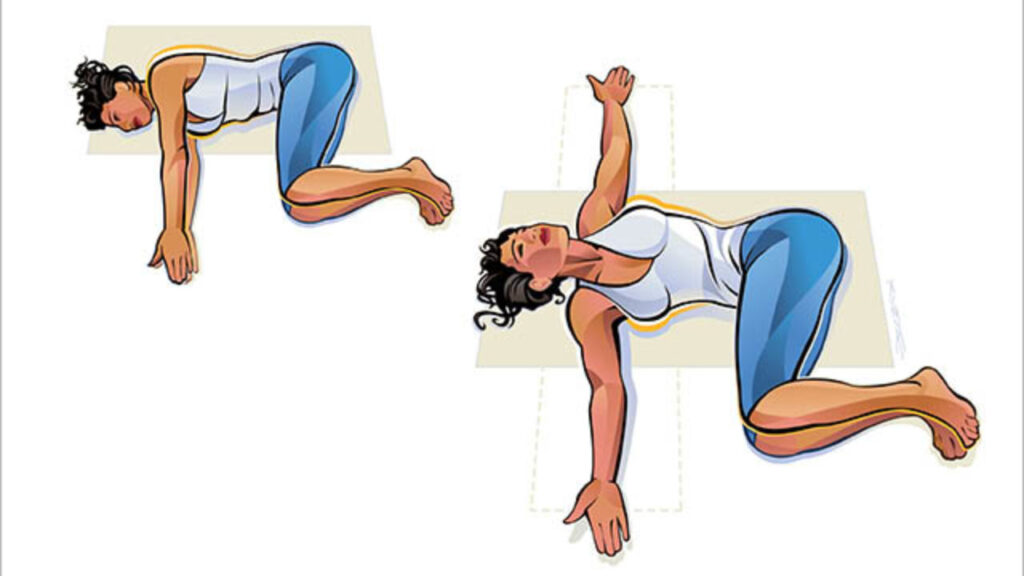
Lie on your side and flex your knees up to hip level.
Extend your arms straight out in front of you and gets your hands together at chest or shoulder height.
Raise your top arm and move it so it falls toward the floor on the other side until you feel a stretch.
Bring your arm back to its starting position.
This exercise offers good rotation in the thoracic spine while you’re in a comfortable, stable position on the ground.
Do 20 to 30 repetitions of this motion daily.
Supine (or seated) thoracic extension with a foam roll, towel roll, or low back chair (for seated)
You can perform this exercise while lying on your back or sitting in a chair with a low back.
Roll up a large towel. Place it between your shoulder blades horizontally. (You can also utilize a foam roller instead of a towel.)
Tighten the stomach as if someone is about to punch you in your gut.
Raise your arms over your head. (If you have shoulder issues, touch your hands to your elbows and take your elbows overhead.)
Straighten your upper back and body over the top of the roll.
This exercise permits you to stretch your entire front side so you can extend your thoracic spine. Perform this stretch 20 to 30 times a day.
Latissumus dorsi stretch
Place your elbows on a bench, chair, couch, or similar object. Your elbows and hands should be shoulder-width apart.
Grab a broomstick or golf club in that position.
Drop your butt down toward the feet, so your chest drops to the floor.
Hold this pose for eight to ten seconds. Perform it 15 times in a row.
You should feel a stretch through the latissimus dorsi, the muscle underneath your armpit.
Shoulder/scapular wall slide

Stand with your forearms against the wall. Or place a foam roller between your forearms and the wall.
Slide your forearms straight up and down the wall, maintaining contact with the wall/foam roller the whole time.
Continue this movement for one minute.
Do it two more times.
Tighten your stomach during the movement, so you don’t cause excess movement in your back.
This exercise does a great job of stimulating the muscles that help upwardly rotate the shoulder blade, creating better motion for your shoulders.
Tennis Elbow Eccentric Exercise
These are some exercise that gives relief in tennis elbow condition:
- Eccentric strengthening exercises (Extension)
- Eccentric strengthening exercises (Flexion)
- Manual Stretching
- Eccentric Stretches with Band
- Finger Extension
- Ball squeeze
- Wrist Extension/Flexion Strengthening
- Wrist Supination/Pronation Strengthening
- Wrist turn
- Wrist turn with weight
- Wrist lift, palm up
- Elbow bend
- Wrist extensor stretch
- Wrist extensor flex
- Fist squeeze
- Towel twist
Eccentric strengthening exercises (Extension)
Grab a weight in your hand.
Place the affected arm on a table with your palm facing down, permitting your hand to hang off the edge of the table.
Use your free hand to flex the affected wrist back as far as you can while lifting the weight.
Slowly lower the hand with the weight in it.
Do it about 10 to 15 times.
After a short break, do this set of exercises two more times.
It’s essential not to use heavy weights. The weight should be about 30% of the maximum weight you can lift. Mild pain is okay, but you shouldn’t put too much strain on the arm.
Eccentric strengthening exercises (Flexion)
Place the elbow of the affected arm on a table, with your forearm upright. Turn the forearm so that the palm of your hand is facing away from you.
Grab a full bottle in the affected hand.
Slowly lower the arm with the bottle, making sure not to flex your wrist.
Allow the bottle to fall into the free hand and move the affected arm back to the upright original position.
Transfer the bottle from the free hand back up to the affected hand.
Do it about 10 to 15 times.
After a short break, do this set of exercises two more times.
It’s best to perform strengthening exercises three times a day.
Manual Stretching
Gentle stretching exercises involving wrist flexion, extension, and rotation. The elbow should be extended and not flexed to improve the amount of stretch as required. These stretches should be held for 15-30 seconds and repeated 5-10 times, at least twice a day.
Vigorous stretching should be prevented – do not stretch to the point of pain that reproduces your symptoms.
Eccentric Stretches with Band
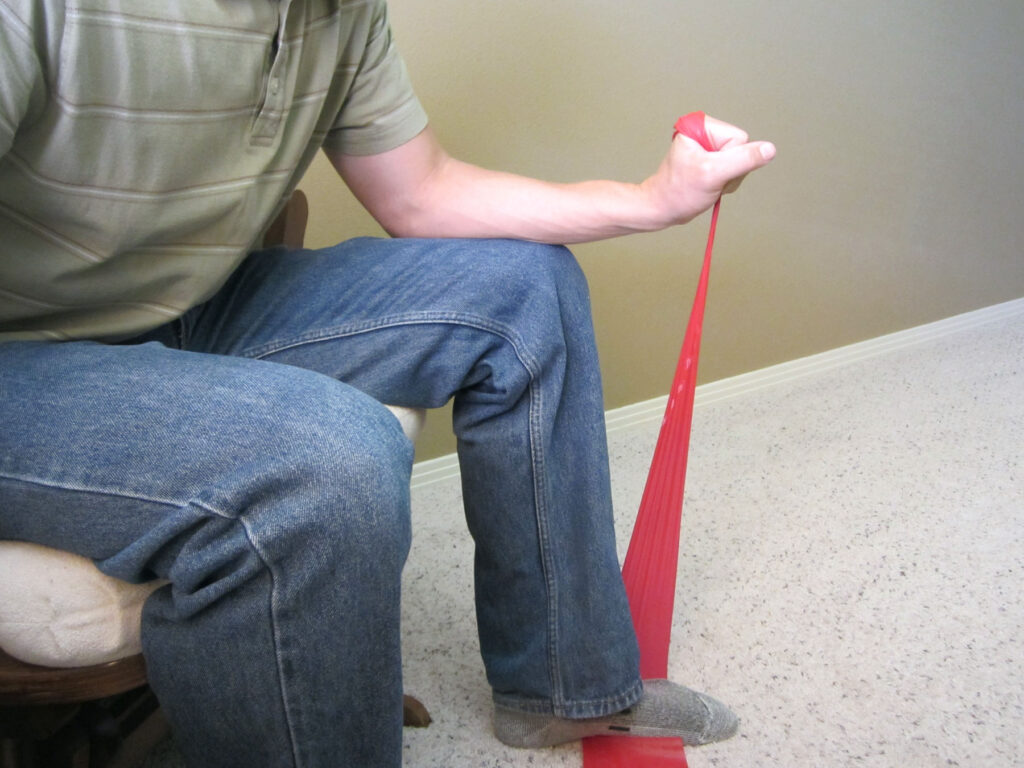
Fix the band firmly under the foot and hold the other end in your hand. Position your elbows straight as possible over your knee and let your wrist towards the ground.
Utilize your unoccupied hand to pull your wrist back towards you stretching the band with it.
Your free hand must perform all the work to bring your wrist back.
Gently release the supporting hand. Slowly let the band pull your wrist down towards the ground. You have now done one exercise. You will need to perform this exercise fifteen times, rest for a minute, perform fifteen more exercises, rest for a minute, and do a final fifteen exercises.
You will have now ended one full exercise session.
For this program, you will need to perform two exercise sessions each day for twelve weeks. Here are some important notes to remember:
Finish the exercises very slowly with a loose band.
You should feel a moderate ache in your elbow towards the end of the exercise session.
Shorten the band or utilize a stiffer band to make the exercise harder as the pain reduces.
Begin to work a little more quickly once you can do an entire session with a stiff band with no pain.
Finger Extension
Position a rubber band around all five fingertips. Spread fingers 20 times, repeat 3 times. If resistance is not enough, add a second rubber band or utilize a rubber band of greater thickness which will provide more resistance.
Ball squeeze
Put a rubber ball or tennis ball in the palm of your hand, squeeze 25 times, and repeat 3 times. If pain is reproduced press a piece of foam or folded sponge.
Wrist Extension/Flexion Strengthening

Wrist Extension. Place 1 lb. weight in hand with palm facing downward (pronated) towards the floor; support forearm at the edge of a table or on the knee so that only your hand can move. Lift wrist/hand up slowly (concentric contraction), and lower slowly (eccentric contraction).
Wrist Flexion. Place 1 lb. weight in hand with palm facing upward (supinated)toward the roof; support forearm at the edge of a table or on the knee so that only your hand can move. Flex wrist up slowly (concentric), and then lower slowly (eccentric)(similar to the exercise above).
Perform 10 repetitions 3-5 times a day.
Start with a 1 lb. weight and do 3 sets of 10 repetitions. When this becomes easy for you, work up to 15 repetitions. Increase the weight only when you can finish 15 repetitions 3 times without difficulty.
Wrist Supination/Pronation Strengthening
Grab hammer in hand with forearm supported. Roll hand to palm down position, return to begin position (hammer perpendicular to the ground), rotate to palm-up position, repeat. To increase or reduce resistance, move your hand farther away or closer to the head of the hammer.
Perform 10 repetitions 3-5 times a day.
Start with a 1 lb. weight and do 3 sets of 10 repetitions. When this becomes easy for you, work up to 15 repetitions. Increase the weight only when you can finish 15 repetitions 3 times without difficulty.
Wrist turn
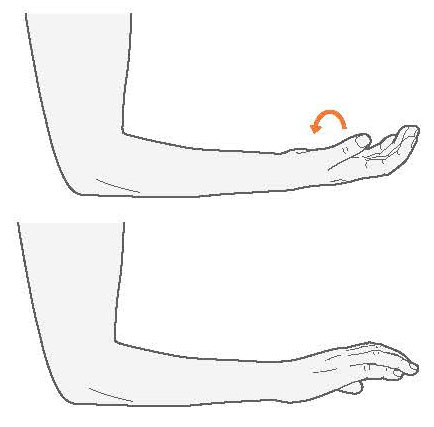
To do a wrist turn:
Flex the elbow at a right angle.
Extend the hand outwards, palm facing upwards.
Twist your wrist around gradually, until the palm is facing downward.
Hold the pose for 5 seconds
Repeat nine more times.
Perform two more sets of 10 repetitions
Wrist turn with weight
The wrist turn with weight is similar to the wrist turn above. But, in this version, the person also grabs a lightweight, such as a small dumbbell or a tin of food.
Wrist lift, palm up
To do a wrist lift, palm up:
grasp a lightweight, such as a small dumbbell or a tin of food.
Flex the elbow at a right angle.
Extend the hand outwards, palm facing upward.
Flex the wrist up towards the body.
Hold this pose for 5 seconds, then release slowly.
Do it nine more times.
Perform two more sets of 10 repetitions.
Elbow bend
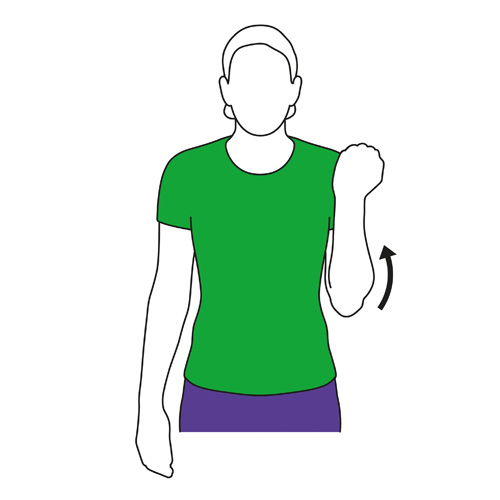
To do the elbow bend:
Stand straight.
Lower the arm to one side.
Slowly flex the arm upwards until the hand touches the shoulder.
Stay in this pose for 15 to 30 seconds.
Do nine more times.
Wrist extensor stretch
To do the wrist extensor stretch:
Lift the arm straight out in front of the body.
With the palm facing downward, slowly flex the wrist downwards.
Using the opposite hand, gently pull the stretching hand back towards the body.
Stay in this pose for 15 to 30 seconds.
Straighten the wrist again.
Repeat twice
Do two more sets of 3 repetitions.
Wrist extensor flex
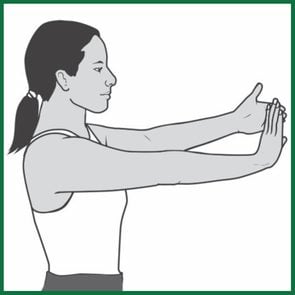
To do the wrist extensor flex:
Lift the arm straight out in front of the body.
With the palm facing down, slowly flex the wrist upwards.
Using the other hand, gently pull the fingers back towards the body.
Stay in this position for 15 to 30 seconds.
Straighten the wrist again.
Repeat twice.
Perform two more sets of 3 repetitions.
Fist squeeze
To do the fist squeeze:
Use a rolled-up towel, sock, or tennis ball and put it in the palm.
Grasp the ball or towel with the fingers to form a fist.
Compress tightly for 10 seconds.
Do it nine more times.
Towel twist
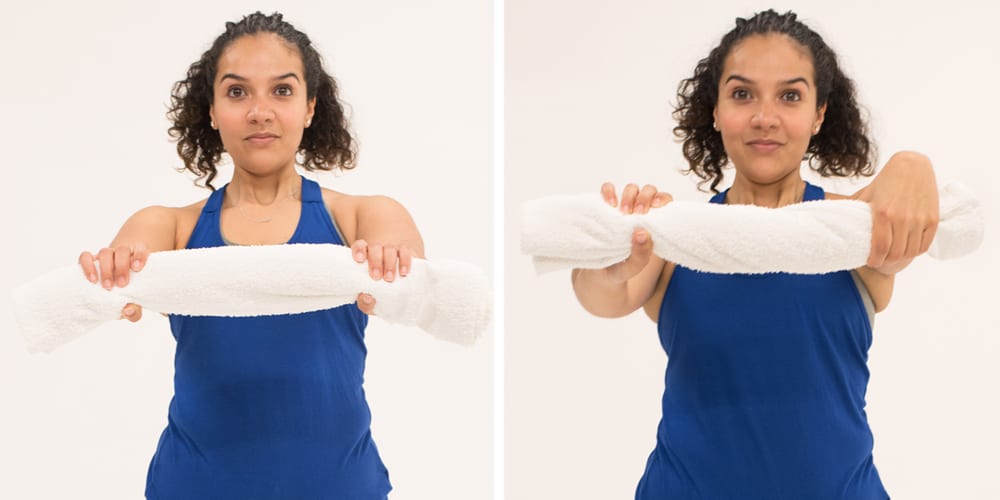
To do the towel twist:
Grab a loosely rolled-up towel length ways, with one hand at each end.
Keep your shoulders relaxed.
Twist the towel by moving the hands in other directions, as if wringing out water.
Do it nine more times.
Then repeat ten more times twisting the towel in the counter direction.
Elbow Exercise after Surgery
There are certain exercises you need to do after surgery, to continue the use of the elbow normally:
- Passive Forearm Rotations
- Active Resisted Extension
- Active Resisted Flexion
Passive Forearm Rotations

Flex your elbow as far as you can.
Using your good hand, grasp the wrist of your other hand.
Keeping your elbow flex, utilize your good hand to gently rotate your forearm further.
Observe that the muscles of your injured arm must remain relaxed, while your good hand does all the work to rotate your arm.
Passive forearm Supination
Roll your forearm further around to get your palm facing up.
Hold this stretched pose for 3-5 seconds.
Passive forearm Pronation
Roll your forearm further around to get your palm facing down.
Hold this stretched pose for 3-5 seconds.
Repeat these alternating positions of Supination and Pronation 10 times.
If these motions are restricted, it will feel like your forearm is stretching. Try and stretch the forearm to the point of discomfort but not pain. Too much pain will inhibit your ability to do the exercises and contribute to a slower recovery.
Active Resisted Extension
Put your injured elbow on a table with the elbow as straight as possible.
Your thumb should be facing upward (as much as possible).
Extend your elbow as far as possible and hold for 5 seconds.
Using your good hand, grab the wrist of your injured elbow (cup your wrist in the hand comfortably so that the palm of your
good hand is facing you).
Try to push against the hand to gain more extension (i.e. try and extend your elbow further against resistance).
Push for 5 seconds. Do it 10 times (minimum). Remember to keep the thumb facing up.
Active Resisted Flexion
In the same position, flex your elbow as far as possible and hold for 5 seconds.
Remember to keep your thumb facing up.
Then using your good hand, put 2 fingers on the wrist of your injured elbow in a position that resists further flexion.
Your good hand should be turned into a pose where the thumb faces the table and you are looking at the back of your good hand.
Try to push against the hand to gain more flexion (i.e. try and flex your elbow further against resistance).
Push for 5 seconds. Do it 10 times (minimum).
Exercise for Elbow Stiffness
There are certain exercises to reduce stiffness in your elbow joint:
- Active Range of Motion
- Active Assisted Elbow Exercises
- Advanced Elbow Exercises
Active Elbow Range of Motion
Active range-of-motion exercises rely on the muscles to move your joint. These exercises also start to strengthen your muscles as you move your elbow against gravity.
Hold each pose for five seconds. Then slowly return to the beginning position. Do 10 repetitions of each exercise, working up to three sets in a row.
Elbow Flexion
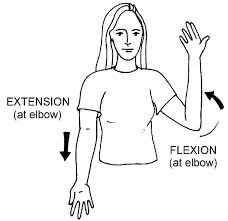
Sit with the arm by your side.
With your thumb pointed toward the roof, bend your elbow as far as possible.
Slowly return to the beginning position.
Repeat this exercise with the palm facing up and again with your palm facing down.
Elbow Extension
Stand with the arm by your side.
Straighten the elbow as far as you can.
Relax and repeat 10 times.
Forearm Supination/Pronation
Sit with your elbow flexed to 90 degrees and thumb pointed toward the roof.
Keep the elbow tight by your side throughout this exercise.
Rotate your forearm into a palm-up pose.
Return to the beginning position.
Repeat 10 times.
Do this same exercise sequence while rotating in a palm-down position.
Active Assisted Elbow Exercises
Active assisted ROM elbow exercises to use your opposite hand to gently increase motion in your affected joint. Do eight to 10 repetitions of each exercise at least four times per day. Hold each stretch for 20 to 30 seconds.
Elbow Flexion

Elbow flexion refers to your ability to flex your elbow. To increase your elbow flexion ROM:
Stand with the arm at your side.
Actively flex your elbow up as far as possible, then grab your forearm or wrist with your other hand and gently add overpressure to the stretch.
Hold the bent pose of your elbow for five to 10 seconds, and then release the stretch by lengthening your elbow.
Do this exercise 10 times.
Elbow Extension
To enhance your ability to fully straighten your elbow, you must work on elbow extension ROM exercises. To perform this:
Sit in a chair with the elbow resting on a table. You may need to place your upper arm on a pillow or folded towel for comfort.
Straighten your elbow out all the way, and then give pressure to your forearm or wrist to add overpressure to the stretch.
Straighten your elbow out as far as you can with overpressure, and pause the stretch for five to 10 seconds.
Let go of the stretch and allow your elbow to bend a bit.
Do this exercise for 10 repetitions.
Forearm Supination

The ability to roll your wrist over so your hand faces up is called supination, and this movement occurs at both your elbow and at your wrist joint. To increase your ability to supinate your hand, do the forearm supination ROM exercise.
To perform the exercise:
Stand or sit with the arm at your side and the elbow bent about 90 degrees.
Keep your elbow at the side and roll your wrist and hand over so your palm faces up.
To add overpressure to the stretch, use your other hand and reach underneath the forearm of your supinated arm. Grasp your wrist and gently add overpressure by turning the hand further into supination. When a stretch is felt, hold the pose for five to 10 seconds.
Do elbow supination ROM for 10 repetitions.
Forearm and Elbow Pronation
Forearm pronation refers to your ability to turn the hand over so your palm faces the ground. This motion is extremely important in doing tasks such as pouring a cup of coffee or playing the piano.
To do the forearm pronation ROM stretch:
Stand or sit with your elbow flexed 90 degrees and tucked in at your side.
Turn the hand and wrist over as far as possible, then reach your opposite hand over the top of your forearm.
Grasp your wrist, and turn your arm further into a pronated position.
Hold the pose with overpressure for five to 10 seconds, and then release the stretch.
Do the pronation ROM stretch 10 times.
Advanced Elbow Exercises
Elbow stiffness that has been present for a long time might need more aggressive stretching techniques. Do these exercises only if advised by your doctor or therapist.
Table Flexion
Stand facing a table or countertop.
Rest the forearms on the surface, keeping the arms close to your body.
Lean your torso over your elbows to stretch them into a bent position.
stay in this pose for 10 seconds, then relax.
Repeat three times.
Wall Flexion
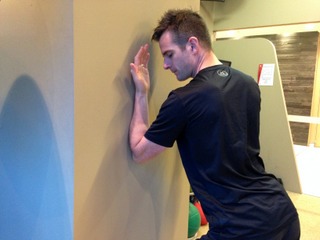
Stand facing a wall.
Put your forearms flat against the wall.
Slowly slide the elbows down the wall to improve the bend in your elbow.
Stop and pause for 10 seconds when you feel a strong pulling sensation.
Repeat three times.
Improve this stretch by stepping closer to the wall.
Supine Elbow Extension
Take a supine position with your arm by your side.
Put a small folded towel under your upper arm.
Grab a dumbbell or other small object weighing 5 pounds or less in your palm.
Relax your elbow, permitting the weight to stretch your arm straight.
Hold for 30 seconds; slowly raise your time as tolerated.
Elbow ROM Exercise
Here are some elbow exercises :
- Elbow Flexion
- Elbow Extension
- Forearm Supination
- Forearm and Elbow Pronation
- Fist squeeze
Elbow Flexion
Flexion defines as the bending of your elbow, which can become hard if you’ve had surgery or suffer from arthritis.
How to do this motion: You’ll stand with the arm at your side, and bend the elbow as far as possible. Then, grab your forearm or wrist with your other hand and add pressure. Hold this pose and then release it by straightening your elbow.
Elbow Extension
If you suffer from pain in the elbow, extending your arm straight is sometimes a difficult feat. While you do not need to over-extend your arm to the point of sharp-shooting pain, you can try this exercise repeatedly to improve strength:
How to do this motion: You’ll sit in a chair with the elbow on a table, with the option to utilize a towel or pillow under the arm for comfort. Straighten the elbow as far as you can, targeting to straighten it all the way, and then give pressure on your forearm or wrist. Hold this stretch for five to 10 seconds, release the elbow, and repeat.
Forearm Supination
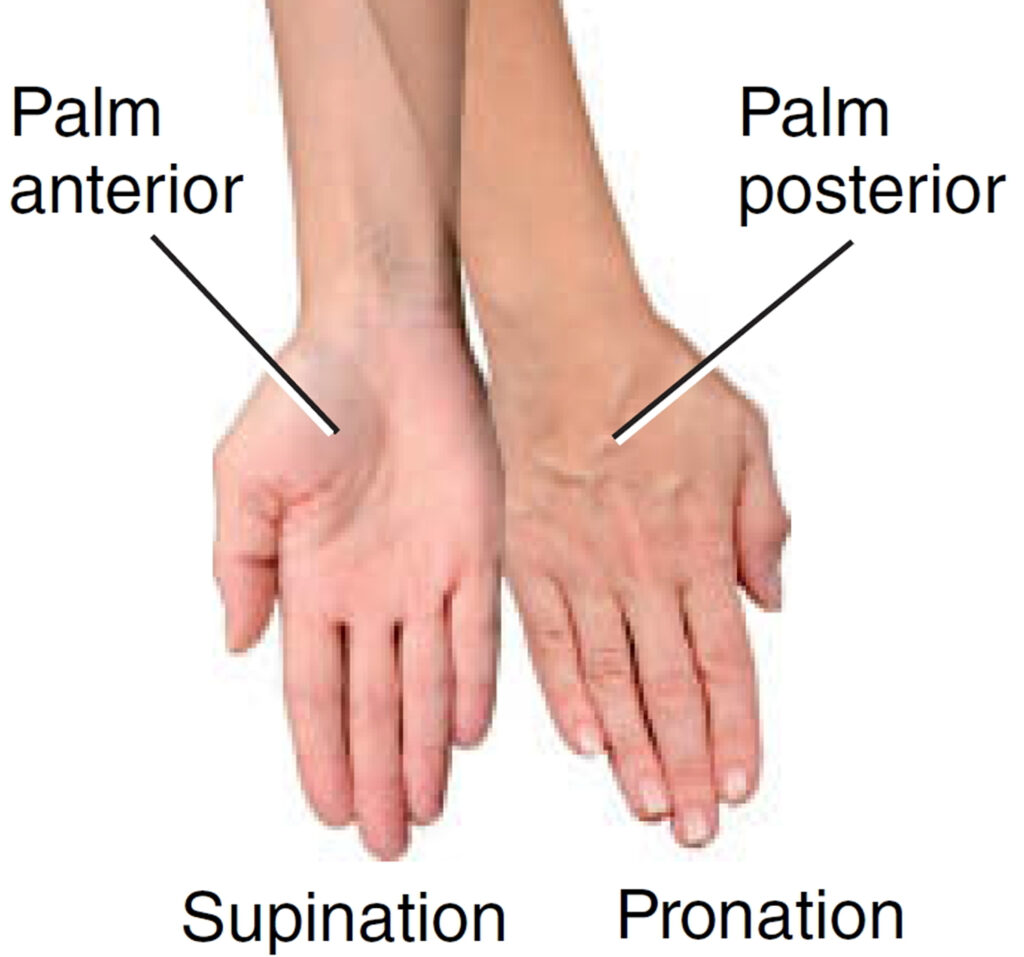
Supination defines as the ability to turn the wrist over so your hand faces upwards, and this movement occurs at your elbow and wrist joints.
How to do this motion: You’ll stand or sit with your elbow flexed at 90 degrees, your arm resting at your side. Keep the elbow at your side and turn your wrist and hand over so the palms face up. You can add pressure to this stretch by utilizing your opposite hand and reaching underneath the forearm of your stretched arm.
Forearm and Elbow Pronation
Work towards turning your hand over so that your palm faces the ground. From pouring a cup of tea to playing the piano, this movement can help to strengthen your elbow and make daily tasks easier.
How to do this motion: You’ll stand or sit with your elbow flexed at 90 degrees, tucked in at your side. Then, turn the hand and wrist over as far as possible. Reach your other hand over the top of your forearm, and grasping your wrist, turn your arm as far as possible without pain. Pause for five to 10 seconds, and repeat.
Fist squeeze
The fist squeeze exercise is a great way to improve your strength and flexibility in the forearm muscles that support your elbows. To perform the exercise, ball up your fist and squeeze 20 to 30 times at least once a day. You can put on the difficulty of the exercise by squeezing a stress ball.

